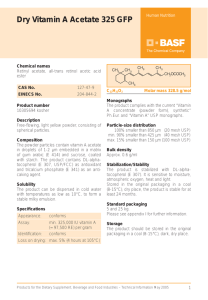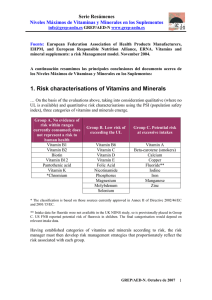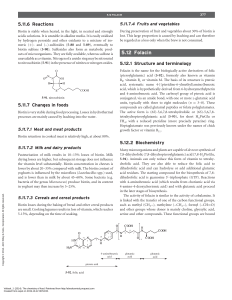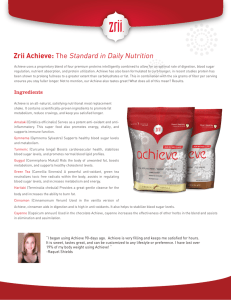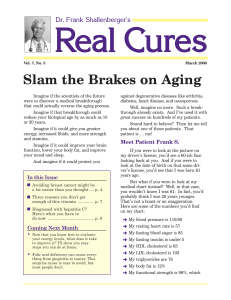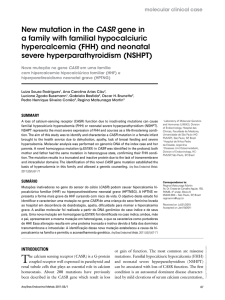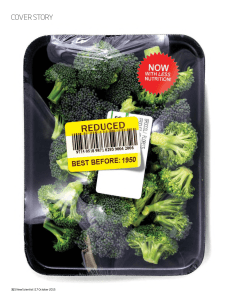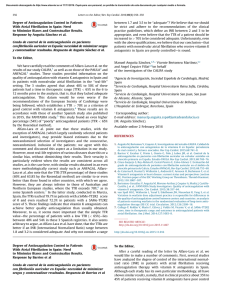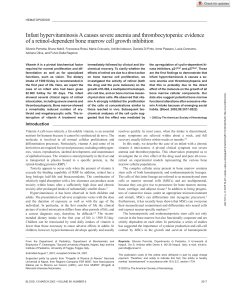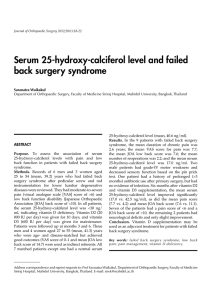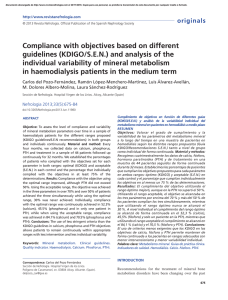Lots of steroids and vitamins, tons of complications
Anuncio
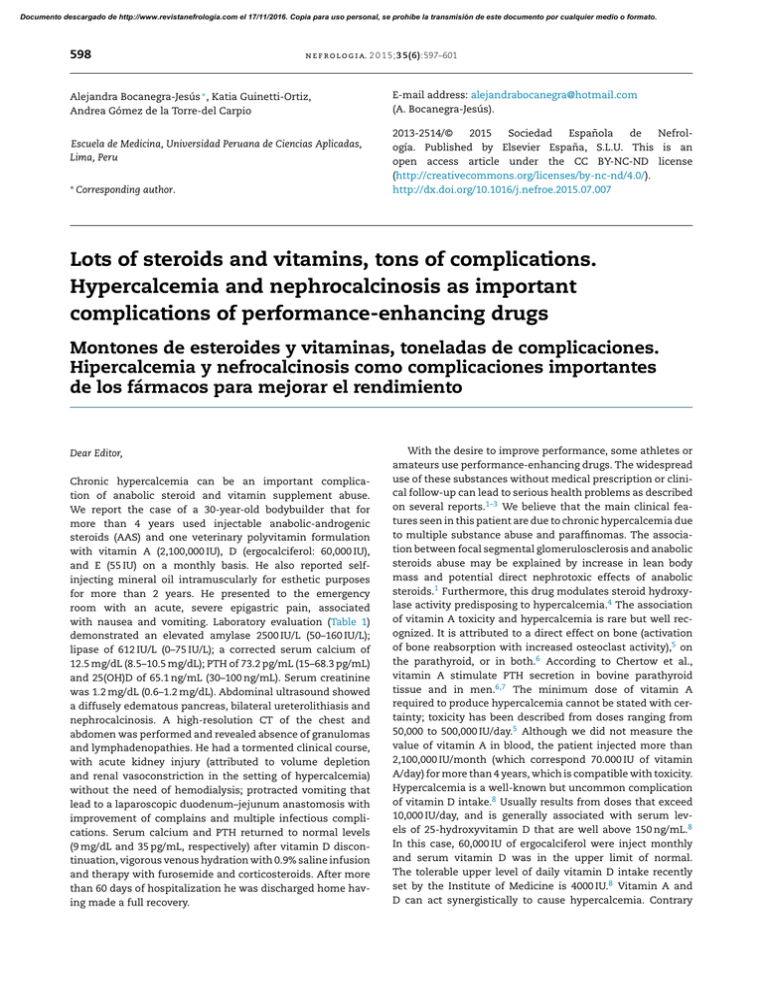
Documento descargado de http://www.revistanefrologia.com el 17/11/2016. Copia para uso personal, se prohíbe la transmisión de este documento por cualquier medio o formato. 598 n e f r o l o g i a. 2 0 1 5;3 5(6):597–601 Alejandra Bocanegra-Jesús ∗ , Katia Guinetti-Ortiz, Andrea Gómez de la Torre-del Carpio Escuela de Medicina, Universidad Peruana de Ciencias Aplicadas, Lima, Peru ∗ Corresponding author. E-mail address: [email protected] (A. Bocanegra-Jesús). 2013-2514/© 2015 Sociedad Española de Nefrología. Published by Elsevier España, S.L.U. This is an open access article under the CC BY-NC-ND license (http://creativecommons.org/licenses/by-nc-nd/4.0/). http://dx.doi.org/10.1016/j.nefroe.2015.07.007 Lots of steroids and vitamins, tons of complications. Hypercalcemia and nephrocalcinosis as important complications of performance-enhancing drugs Montones de esteroides y vitaminas, toneladas de complicaciones. Hipercalcemia y nefrocalcinosis como complicaciones importantes de los fármacos para mejorar el rendimiento Dear Editor, Chronic hypercalcemia can be an important complication of anabolic steroid and vitamin supplement abuse. We report the case of a 30-year-old bodybuilder that for more than 4 years used injectable anabolic-androgenic steroids (AAS) and one veterinary polyvitamin formulation with vitamin A (2,100,000 IU), D (ergocalciferol: 60,000 IU), and E (55 IU) on a monthly basis. He also reported selfinjecting mineral oil intramuscularly for esthetic purposes for more than 2 years. He presented to the emergency room with an acute, severe epigastric pain, associated with nausea and vomiting. Laboratory evaluation (Table 1) demonstrated an elevated amylase 2500 IU/L (50–160 IU/L); lipase of 612 IU/L (0–75 IU/L); a corrected serum calcium of 12.5 mg/dL (8.5–10.5 mg/dL); PTH of 73.2 pg/mL (15–68.3 pg/mL) and 25(OH)D of 65.1 ng/mL (30–100 ng/mL). Serum creatinine was 1.2 mg/dL (0.6–1.2 mg/dL). Abdominal ultrasound showed a diffusely edematous pancreas, bilateral ureterolithiasis and nephrocalcinosis. A high-resolution CT of the chest and abdomen was performed and revealed absence of granulomas and lymphadenopathies. He had a tormented clinical course, with acute kidney injury (attributed to volume depletion and renal vasoconstriction in the setting of hypercalcemia) without the need of hemodialysis; protracted vomiting that lead to a laparoscopic duodenum–jejunum anastomosis with improvement of complains and multiple infectious complications. Serum calcium and PTH returned to normal levels (9 mg/dL and 35 pg/mL, respectively) after vitamin D discontinuation, vigorous venous hydration with 0.9% saline infusion and therapy with furosemide and corticosteroids. After more than 60 days of hospitalization he was discharged home having made a full recovery. With the desire to improve performance, some athletes or amateurs use performance-enhancing drugs. The widespread use of these substances without medical prescription or clinical follow-up can lead to serious health problems as described on several reports.1–3 We believe that the main clinical features seen in this patient are due to chronic hypercalcemia due to multiple substance abuse and paraffinomas. The association between focal segmental glomerulosclerosis and anabolic steroids abuse may be explained by increase in lean body mass and potential direct nephrotoxic effects of anabolic steroids.1 Furthermore, this drug modulates steroid hydroxylase activity predisposing to hypercalcemia.4 The association of vitamin A toxicity and hypercalcemia is rare but well recognized. It is attributed to a direct effect on bone (activation of bone reabsorption with increased osteoclast activity),5 on the parathyroid, or in both.6 According to Chertow et al., vitamin A stimulate PTH secretion in bovine parathyroid tissue and in men.6,7 The minimum dose of vitamin A required to produce hypercalcemia cannot be stated with certainty; toxicity has been described from doses ranging from 50,000 to 500,000 IU/day.5 Although we did not measure the value of vitamin A in blood, the patient injected more than 2,100,000 IU/month (which correspond 70.000 IU of vitamin A/day) for more than 4 years, which is compatible with toxicity. Hypercalcemia is a well-known but uncommon complication of vitamin D intake.8 Usually results from doses that exceed 10,000 IU/day, and is generally associated with serum levels of 25-hydroxyvitamin D that are well above 150 ng/mL.8 In this case, 60,000 IU of ergocalciferol were inject monthly and serum vitamin D was in the upper limit of normal. The tolerable upper level of daily vitamin D intake recently set by the Institute of Medicine is 4000 IU.8 Vitamin A and D can act synergistically to cause hypercalcemia. Contrary Documento descargado de http://www.revistanefrologia.com el 17/11/2016. Copia para uso personal, se prohíbe la transmisión de este documento por cualquier medio o formato. 599 n e f r o l o g i a. 2 0 1 5;3 5(6):597–601 Table 1 – Laboratory evaluation Parameter Reference range On admission 48 h One week Hemoglobin Creatinine Urea Lipase Amylase Corrected Calcium Albumin PTH 25-OH-VIT D Phosphorus Triglyceride 14.3–18.3 g/dL 0.6–1.2 mg/dL 20–44 mg/dL 0–75 IU/L 50–160 IU/L 8.5–10.5 mg/dL 2.9–5.2 g/dL 15–68.3 pg/mL 30–100 ng/mL 2.5–4.5 mg/dL 50–200 mg/dL 14.8 g/dL 1.2 52.93 612 2500 12.5 3.0 73.2 65.1 3.8 61 13.1 3.8 125 456 1430 12.3 2.5 70.2 13.6 1.92 84.4 321 234 11.1 3.0 38 56.2 3.2 3.0 Two weeks 1.4 43 At discharge 12.9 0.7 36 63 88 9.0 2.4 35 69.7 4.0 185 Fig. 1 – Evolution of physical tone during hospitalization. to what we were expecting, the patient described here presented with hypercalcemia and moderated increased serum PTH, instead of suppression of the activity of this hormone by multidrug and vitamin abuse. Multifactorial mechanisms may be involved and some possible explanations are: vitamin A intoxication may have had a leading role in the development of hypercalcemia and itself may increase PTH secretion6 ; parathyroid overactivity has been described in critical illness associated with sepsis and renal failure (life-threatening tertiary hyperparathyroidism).9 Primary hyperparathyroidism from adenoma or hyperplasia was excluded by negative imaging studies and the restoration of serum calcium and PTH to normal levels after discontinuation of the drugs. Finally, in the case reported here there was a peculiar involvement of the neck and the arms due to self-injection of mineral oil, more apparent after the significant weight loss observed (more than 30 kg) by the patient (Fig. 1). Biopsy of the affected skin revealed multinucleated giant cells and inflammatory infiltrates. These lesions, called paraffinomas, may have contributed to hypercalcemia due to PTH-independent, extrarenal production of 1,25-dihydroxy-vitamin D by activated mononuclear cells.10 In conclusion, clinicians need to be aware that AAS and multivitamin abuse can occur with relative frequency and their use can be surreptitious. The simultaneous occurrence of nephrocalcinosis, nephrolithiasis, acute kidney injury and acute pancreatitis may be a clue to the diagnosis of associated chronic hypercalcemia. references 1. Herlitz LC, Markowitz GS, Farris AB, Schwimmer JA, Stokes MB, Kunis C, et al. Development of focal segmental glomerulosclerosis after anabolic steroid abuse. J Am Soc Nephrol. 2010;21(1):163–72 [Pubmed]. 2. Caldeira C, Neves WS, Cury PM, Serrano P, Baptista MA, Burdmann EA. Rhabdomyolysis, acute renal failure, and death after monensin ingestion. Am J Kidney Dis. 2001;38(5):1108–12 [Pubmed]. 3. Daher EF, Silva Junior GB, Queiroz AL, Ramos LM, Santos SQ, Barreto DM, et al. Acute kidney injury due to anabolic steroid and vitamin supplement abuse: report of two cases and a literature review. Int Urol Nephrol. 2009;41(3):717–23 [Pubmed]. Documento descargado de http://www.revistanefrologia.com el 17/11/2016. Copia para uso personal, se prohíbe la transmisión de este documento por cualquier medio o formato. 600 n e f r o l o g i a. 2 0 1 5;3 5(6):597–601 4. Samaha AA, Nasser-Eddine W, Shatila E, Haddad JJ, Wazne J, Eid AH. Multi-organ damage induced by anabolic steroid supplements: a case report and literature review. J Med Case Rep. 2008;2:340 [Pubmed]. 5. Penniston KL, Tanumihardjo SA. The acute and chronic toxic effects of vitamin A. Am J Clin Nutr. 2006;83(2):191–201 [Pubmed]. 6. Miller P, Sweny P, Persaud JW, Varghese Z, Farrington K, Chan MK, et al. The effects of vitamin A toxicity on calcium and lipid metabolism in chronic renal failure. Proc Eur Dial Transplant Assoc. 1981;18:573–8 [Pubmed]. 7. Chertow BS, Williams GA, Norris RM, Baker GR, Hargis GK. Vitamin A stimulation of parathyroid hormone: interactions with calcium, hydrocortisone, and vitamin E in bovine parathyroid tissues and effects of vitamin A in man. Eur J Clin Invest. 1977;7(4):307–14 [Pubmed]. 8. Rosen CJ. Clinical practice. Vitamin D insufficiency. N Engl J Med. 2011;364(3):248–54 [Pubmed]. 9. Jeffries CC, Ledgerwood AM, Lucas CE. Life-threatening tertiary hyperparathyroidism in the critically ill. Am J Surg. 2005;189(3):369–72 [Pubmed]. 10. Gyldenlove M, Rorvig S, Skov L, Hansen D. Severe hypercalcaemia, nephrocalcinosis, and multiple paraffinomas caused by paraffin oil injections in a young bodybuilder. Lancet. 2014;383(9934):2098 [Pubmed]. Claudia Bento a,∗ , Pedro Velho b , Maurício Carvalho b a b Servicio de Nefrología, CHTMAD - Vila Real, Vila Real, Portugal Servicio de Nefrología, Hospital de clinicas, Curitiba, Brazil ∗ Corresponding author at: Servicio de Nefrología, CHTMAD - Vila Real, Avenida da Noruega, Lordelo, Vila Real 5000-508, Portugal. E-mail address: [email protected] (C. Bento). 2013-2514/© 2015 Sociedad Española de Nefrología. Published by Elsevier España, S.L.U. This is an open access article under the CC BY-NC-ND license (http://creativecommons.org/licenses/by-nc-nd/4.0/). http://dx.doi.org/10.1016/j.nefroe.2015.10.008 Valvular calcifications in chronic kidney disease: Mineral and bone disease or previous cardiovascular risk? Response夽 Calcificaciones valvulares en enfermedad renal crónica:¿enfermedad mineral ósea o riesgo cardiovascular previo? Respuesta To the Editor, We thank Dr. Bocanegra et al. for their interest in our study.1 In their comments, they pointed out that the methods section did not provide the values of phosphorus, calcium, and PTH of the patients with and without valvular calcification (VC). Values of these parameters were not shown because we decided to include in the table only those values with differences that were statistically significant. Therefore, the values of phosphorus, being significantly different, were shown in Table 1 of the original article. In our study, the values of calcium and PTH were similar in both patient groups, with and without VC, and were within the range recommended by the KDOQI, as shown in Table 1 of this letter. Regarding the comment on the multivariate analysis of factors associated with VC, we would like to offer the following clarification: the analysis performed included those variables that showed a statistically significant difference between groups, including phosphorus. The analysis also included other variables that could have been associated with the calcification process: lipids, C-reactive protein, PTH, and calcium, though these variables were inadvertently omitted from text. We therefore thank Bocanegra et al. for the opportunity to provide this information. The results of the multivariate analysis showed that older age and lower albumin level were independently associated with VC, as shown in Table 3 of the article. As Bocanegra et al. pointed out, our study demonstrates that the presence of VC is an independent risk factor for cardiovascular events and cardiovascular death, although it does not establish the factors involved in the development of VC, other than older age and lower albumin level. Similarly to other studies,2 our study found no association between VC and the biochemical abnormalities of bone mineral metabolism that are measured in routine clinical practice. Likewise, there was no association with atherogenic comorbidities nor with established atherosclerosis. This association has not been evaluated in most of the studies on VC in incident dialysis patients. In prevalent dialysis patients, VC has been associated with a history of cardiovascular events and left ventricular hypertrophy.3 The precise cellular and molecular mechanisms that drive cardiac and vascular ectopic calcification are not fully 夽 Please cite this article as: Perales CS, de Castroviejo EVR. Calcificaciones valvulares en enfermedad renal crónica:¿enfermedad mineral ósea o riesgo cardiovascular previo? Respuesta. Nefrología. 2015;35:600–601.

